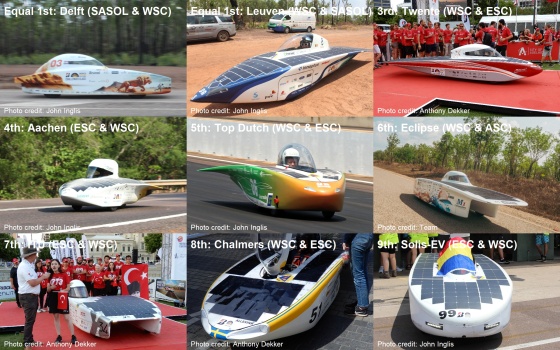Looking back on the Bridgestone World Solar Challenge, I wanted to highlight some technical innovations in a number of different areas. As always, click images to zoom.
Teams, please message me if I’ve gotten anything wrong.
Electrical
Top Dutch always sets a great example in being open. Below is their very professional battery box (they also received the Safety Award). Estidamah also shared their battery box, designed with safety in mind:

 Top Dutch’s battery box (left, credit: Anthony Dekker) and Estidamah’s (right, credit: Anthony Dekker)
Top Dutch’s battery box (left, credit: Anthony Dekker) and Estidamah’s (right, credit: Anthony Dekker)
Top Dutch also used cutting-edge perovskite-on-silicon tandem solar cells from Oxford PV (sadly damaged in a pre-race accident). These cells offer a roughly 20% higher efficiency than standard silicon, and in spite of the damage, the team still came 6th.
 Top Dutch’s solar panel (credit: Anthony Dekker)
Top Dutch’s solar panel (credit: Anthony Dekker)
It is also worth noting that the top 4 Challenger teams (Leuven, Twente, Delft, and Michigan) all used silicon-anode batteries from Amprius.
Steering, Motors, and Suspension
Delft/Brunel this year had an asymmetrical three-wheel car (as they did in 2021), steered by the front and side wheels. The steering wheel connects via a belt to a central rotating rod, which in turn connects to each wheel:

 Delft’s Nuna 12 and interior showing steering (left credit: John Inglis, right: Anthony Dekker)
Delft’s Nuna 12 and interior showing steering (left credit: John Inglis, right: Anthony Dekker)
Kogakuin University Solar Team is always a powerhouse of innovation. Their car this year had revolutionary movable rear wheels. Bringing the rear wheels forward (and further apart) improves stability. They also had an unusual nonlinear suspension. The team reports:
“There is no need for an internal beam to hang the suspension, so the car has more living space. Because the suspension is supported from the ground chassis, it has a low center of gravity. It is installed on a round rail and can rotate the tire in any direction. This is the unit that includes the electric motor, suspension, etc. Easily integrated into the flat base chassis of electric vehicles. When multiple units are installed in a car, their suspensions are hydraulically connected to each other, and it also has a function that maintains the vehicle body angle at a constant angle to improve ride comfort and aerodynamic performance.”

 Kogakuin’s suspension system – hydraulic tubes are visible on the right (left credit: team, right: Anthony Dekker)
Kogakuin’s suspension system – hydraulic tubes are visible on the right (left credit: team, right: Anthony Dekker)
Deakin/Ascend’s Cruiser had an innovative 3D-printed titanium upright in their suspension, and for ease of access and other reasons used a pair of electric aircraft motors from Slovenian company Emrax:

 Deakin’s titanium upright and motors (credit: John Inglis)
Deakin’s titanium upright and motors (credit: John Inglis)
Solaride’s Cruiser also had a Slovenian motor, from GEM.
Aerodynamics & Body
The Belgian team credits their famous retractable and rotatable fin both with increasing speed during side winds and with improving stability. They received the The CSIRO Technical Innovation Award for this and other features. They say (my translation):
“It is not only the energy efficiency that gives us a competitive advantage. Thanks to the fin, the car drives more stably in crosswinds. During the WSC, the solar car was able to maintain its speed where other teams had to slow down.”
 The famous fin at the finish line (credit: Anthony Dekker)
The famous fin at the finish line (credit: Anthony Dekker)
Jönköping University (JU) made their body from sustainable flax fibre. They say:
“Flax fiber is lighter than carbon fiber, which means our car will have less weight and better performance. In addition, flax fiber is a renewable resource and biodegradable, making it more environmentally friendly than carbon fiber. Another advantage of the material is its high strength and stiffness, making it a suitable option for reinforcing and stabilizing the car body. This is particularly important given the challenges of the Bridgestone World Solar Challenge 2023. Flax fiber has the ability to resist vibrations and shocks better than carbon fiber, making it a safer material for the body. … In summary, flax fiber is a relatively new material for solar cars and other vehicles, and there is still some uncertainty about its performance and durability over time. Despite this, we at JU Solar Team have chosen to use flax fiber for our new solar car, and we are convinced that it is the best choice for us.”
 JU’s flax-fibre body (credit: Anthony Dekker)
JU’s flax-fibre body (credit: Anthony Dekker)
Command and Control
I am using military terminology deliberately here, because leading a solar car convoy through the desert has certain similarities with leading a military team.
Chalmers has used the what3words geocode system for error-resistant communication of location information (on this system, the famous Three Rivers Fountain would be coded as “former.even.photo”). It should be noted, however, that this system has its critics, and it may work better for text communication than for voice. I understand that this was also the team’s experience.
Sunswift has more or less re-invented what the military calls “reach-back” – and congratulations to them for doing so!
“Reach-back support is a relatively new concept. It provides operational warfighting units – battalions and brigades – the opportunity to reach outside of their traditional avenues of information flow and use national intelligence community assets to gather information to fill ‘gaps’ in tactical intelligence.” (Capt. Phillip Radzikowsk, 2008, ‘Reach-Back’—A New Approach To Asymmetrical Warfare Intelligence)
The Sunswift “Racecube,” back in Sydney, receives live telemetry that is processed by data analysts and strategists. These in turn provide advice back to the decision-makers in the chase vehicle. The result is a strategy team much bigger than would fit in the back of a van. Of course, this is only possible through satellite communication.
 Sunswift’s “Racecube” (credit: team)
Sunswift’s “Racecube” (credit: team)
















































